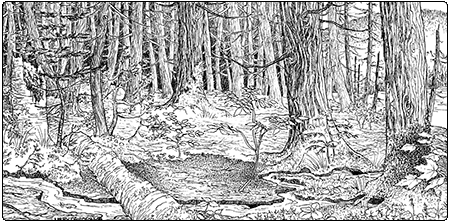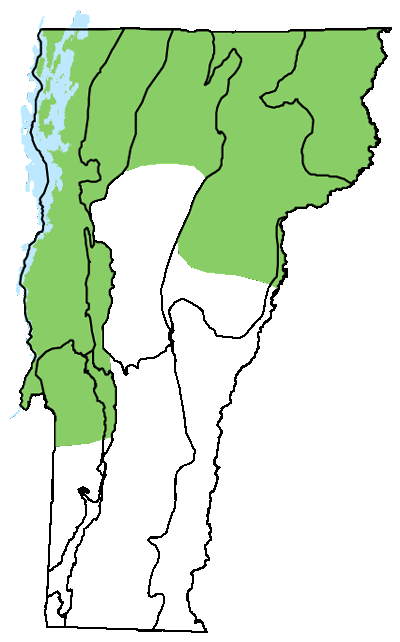Ecology and Physical Setting
Northern White Cedar Seepage Forests occur on gentle slopes and have shallow accumulations of highly decomposed organic soil, which is typically less than 1.5 feet deep. They are strongly associated with groundwater seepage, usually from calcium-rich bedrock or till. Small streams that flow over the underlying mineral soil may appear and disappear under the shallow organic soils. Even when water is not visible, it can often be heard gurgling and trickling below the shallow roots of the cedar trees. Seasonally drier soil conditions may be responsible for the highly decomposed and shallow nature of the surface organic soil horizon. The ground surface is mostly uniform, with the exception of occasional small hummocks and incised streams.
Northern White Cedar Seepage Forests often occur on slopes adjacent to Northern White Cedar Swamps, but the forests and swamps are distinct in their structure, soils, and understory vegetation. These seepage forests also occur at the edges of ponds.
Vegetation

but it has not been seen in many years.
Northern White Cedar Seepage Forests have closed canopies and typically have sparse shrub, herb, and bryophyte cover. The dense canopy is dominated by northern white cedar. Yellow birch is a common canopy associate. Other trees include balsam fir, black ash, red spruce, and white spruce. Shrub cover is very sparse. The most frequently occurring species are seedlings and saplings of canopy species, along with Canada honeysuckle, alder-leaved buckthorn, and mountain maple. Herbaceous cover is generally sparse except under canopy openings. Characteristic herbs include a mixture of upland and wetland species, reflecting the seasonally dry nature of these seepage forests. Common wood sorrel and foamflower are often abundant. Other species include intermediate wood fern, oak fern, lady fern, dwarf raspberry, bluebead lily, sarsaparilla, pedunculate sedge, and shining clubmoss. The fine-leaved sedges (three-seeded sedge, two-seeded sedge, and bristle-stalked sedge) are absent from many sites, in contrast to their abundance in cedar swamps.
Northern White Cedar Seepage Forests have a very sparse cover of bryophytes. Often, much of the ground is bare of vegetation, and has a thick cover of cedar twigs and needles. Shaggy moss is the most abundant species, reflecting its preference for wet calcareous soils. Stair-step moss and three-lobed bazzania are present in most forests, but are seldom abundant. The moss Fissidens adianthoides is common along the shady edges of small streams.
The shallow-rooted cedar trees commonly blow down in small patches. In these openings, lateral cedar branches become new trees and there can be thickets of cedar and other tree regeneration, along with abundant shrubs and herbs.
Wildlife Habitat
Northern White Cedar Seepage Forests provide winter cover and food for white-tailed deer. The seeps and springs at the forest margins, and the small streams flowing through the forest, provide habitat for several salamanders, including northern two-lined salamander, northern dusky salamander, and spring salamander. The groundwater that discharges into Northern White Cedar Seepage Forests results in cold-water perennial streams that support brook trout—small trout can be present even in the streams flowing through the seepage forests. Breeding birds include Canada warbler, northern parula, yellow-rumped warbler, and the uncommon northern saw-whet owl.
Related Communities
- Northern White Cedar Swamps are also dominated by cedar, but have deeper organic soils, nearly imperceptible slopes, and a greater cover of shrubs, herbs, and bryophytes, many of which reflect mineral-rich ground water influence.
- Boreal Cedar-Sphagnum Basin Swamps are also dominated by cedar, but have deeper organic soils, a nearly complete sphagnum cover, and more acidic water.
Conservation Status and Management Considerations
Many Northern White Cedar Seepage Forests have been harvested in the past; few remain in mature condition. Conserving remaining old forest examples and allowing others to mature will help to conserve the species and natural processes associated with this uncommon wetland natural community. Several high-quality examples occur on public lands.
Distribution/Abundance
This uncommon natural community occurs in northern Vermont, as well as New York, New Hampshire, Maine, Québec, and New Brunswick.
Characteristic Plants
Trees
Abundant Species
Northern white cedar – Thuja occidentalis
Occasional to Locally Abundant Species
Yellow birch – Betula alleghaniensis
Balsam fir – Abies balsamea
White spruce – Picea glauca
Red spruce – Picea rubens
Red maple – Acer rubrum
Eastern hemlock – Tsuga canadensis
Shrubs
Canada honeysuckle – Lonicera canadensis
Mountain maple – Acer spicatum
Alder-leaved buckthorn – Rhamnus alnifolia
Mountain holly – Ilex mucronata
Herbs
Common wood sorrel – Oxalis montana
Foamflower – Tiarella cordifolia
Intermediate wood fern – Dryopteris intermedia
Oak fern – Gymnocarpium dryopteris
Lady fern – Athyrium filix-femina
Dwarf raspberry – Rubus pubescens
Bluebead lily – Clintonia borealis
Sarsaparilla – Aralia nudicaulis
Pedunculate sedge – Carex pedunculata
Shining clubmoss – Huperzia lucidula
Jack-in-the-pulpit – Arisaema triphyllum
Goldthread – Coptis trifolia
Naked mitrewort – Mitella nuda
Bunchberry – Cornus canadensis
Drooping woodreed – Cinna latifolia
Crested wood fern – Dryopteris cristata
Red trillium – Trillium erectum
One-sided pyrola – Orthilia secunda
Bryophytes
Shaggy moss – Rhytidiadelphus triquetrus
Stair-step moss – Hylocomium splendens
Moss – Fissidens adianthoides
Three-lobed bazzania – Bazzania trilobata
Liverwort – Trichocolea tomentella
Rare and Uncommon Plants
Fairy-slipper – Calypso bulbosa
Ram’s head lady’s slipper – Cypripedium arietinum
Small yellow lady’s slipper – Cypripedium parviflorum var. makasin
White adder’s mouth – Malaxis monophyllos var. brachypoda
Associated Animals
Northern two-lined salamander – Eurycea bislineata
Northern dusky salamander – Desmognathus fuscus
Spring salamander – Gyrinophilus porphyriticus
Southern red-backed vole – Myodes gapperi
White-tailed deer – Odocoileus virginianus
Northern waterthrush – Parkesia noveboracensis
Canada warbler – Cardellina canadensis
Northern parula – Parula americana
Yellow-rumped warbler – Setophaga coronata
White-throated sparrow – Zonotrichia albicollis
Dark-eyed junco – Junco hyemalis
Rare and Uncommon Animals
Northern saw-whet owl – Aegolius acadicus
Places to Visit
Silvio O. Conte National Fish and Wildlife Refuge, Lewis, U.S. Fish and Wildlife Service
West Mountain Wildlife Management Area, Ferdinand, Vermont Fish and Wildlife Department (VFWD)
Bald Hill Wildlife Management Area, Newark, VFWD
Calendar Brook Wildlife Management Area, Sutton, VFWD
Willoughby State Forest, Sutton, Vermont Department of Forests, Parks, and Recreation
